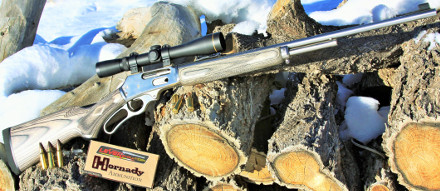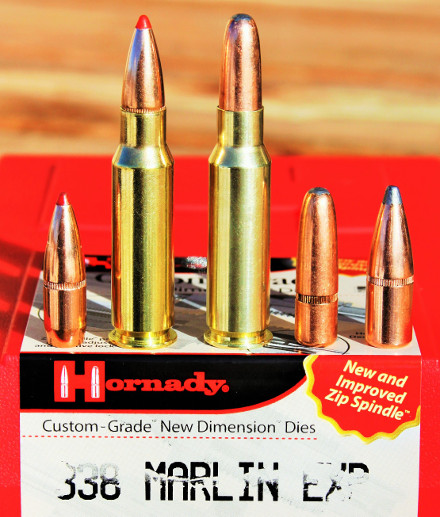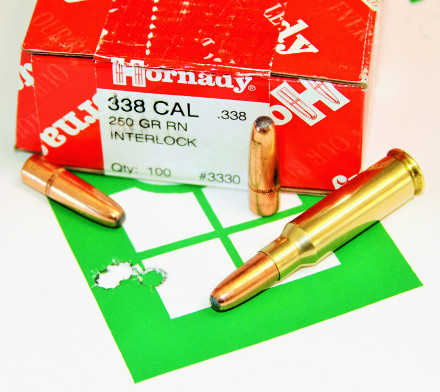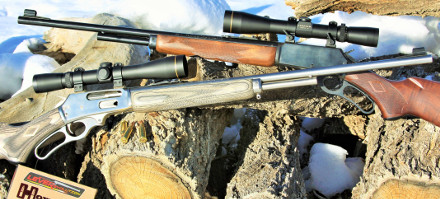
In 2006, Hornady created a serious upgrade to longer range, lever gun performance, through the introduction of the LEVERevolution line of ammo. Traditionally, lever action cartridges have been loaded with flat point or round nose bullets. Spire points can cause multiple round detonations in the magazine tube when fired because the pointy nose rests on the primer of the cartridge in front of it. Hornady solved this problem with the Flex Tip bullet, placing a compressible, flexible tip in the nose of a spire point projectile. Down range performance improved dramatically, as the sleek profile of the Flex Tip maintained velocity much better, which also decrease bullet drop at mid and longer ranges.
In the case of the larger caliber rounds, like the .444 Marlin and the .45-70, putting a point on a short, fat bullet can only do so much. Up close, they deliver like the Hammer of Thor, but also while producing significant recoil to the shooter. A .30 caliber like the .308 Marlin Express can flatten trajectories, but hunters of larger game, like black bears, elk or moose, feel more confident with a bullet of more than 160 grains. When the .308 Marlin came out a few years ago, I felt it was a significant improvement over the .30-30 Winchester but did not have the smashing power of the .444 or .45-70. “How about a .338?” I suggested to a good friend at Hornady while at the SHOT Show introduction of the .308 Marlin, but a cold shoulder was all I got in return. Then at the 2009 show, Marlin and Hornady proudly introduced the new .338 Marlin Express. It duplicates the power of the classic .348 Winchester at the muzzle, but runs away in down range performance due to the sleek, aerodynamic new 200 grain Flex Tip, boat tail bullet, designed for the new Marlin round.
Chapter 1: Cartridge Development and Rifles
Click to LOAD DATA SHEET
The action length of the Marlin rifle limits how long a cartridge can be, so if one desires more capacity for greater speed, increasing the case diameter was the way for Hornady’s Dave Emary to go. Loosely based on the .376 Steyr case, the .338 Marlin Express is a shortened version at 1.890” with a heavier web for greater strength, and a rim for smooth operation in the lever gun. They re-engineered their 200...
grain .338 Winchester Magnum bullet with a thinner jacket to upset at long range, added a boat tail for improved aerodynamics, and of course, made use of Flex Tip technology up front. The result is a bullet for a lever action rifle with a ballistic coefficient (BC) of 0.430; nearly double or triple the more classic flat point or round nose projectiles long being loaded in lever guns.

The performance of the cartridge is such that it is virtually neck-to-neck with the 180 grain load in the .30-06, as far as energy and trajectory to past 300 yards; recoil is also comparable. My shoulder tells me that anyone who can shoot a .308 or .30-06 can comfortably handle the .338 Marlin. Careful powder selection resulted in a speed of 2,521 fps from the 24” barrel of the stainless, laminated Marlin 338MXLR at pressures of only 46,500 psi.
Traditionalists can also choose the blued and walnut 338MX with the slightly shorter 22” barrel. In either case, the 2/3rds length magazine tube holds 5 rounds plus one in the chamber. For my testing, I requested one of each style and mounted Leupold 3-9 European scopes with 30mm tubes, using Warne quick release medium height scope rings.
Please refer to the comparison chart that includes the .444 Marlin and the .45-70 Government round. The numbers are very revealing and go a long way in support of the new cartridge’s reason for being developed. At the muzzle, the .338 produces just over 2,900 ft. lbs., the .45-70 does 2,886, while the .444 hits 3,181… all in LEVERevolution ammunition. At 100 yards, the ballistic superiority of the .200 grain Flex Tip takes over, besting the energy of the .45-70 by over 450 ft. lbs., and the .444 by almost 200.
At 200 yards, the .444 is almost 500ft. lbs. behind, and the .45-70 is nearly 660 behind the .338 Marlin. At that same distance, the .45-70 has to be sighted 5.5” high at 100, to be zeroed at 200, while the .338 is only 2.4” high at 100. Note that the .444 has to be 3.8” high at 100 to be zeroed at 200. Notice how at 300 yards, the .444 is 7” lower than the .338, while the .45-70 is shooting almost 18” lower than the .338, having a drop from 200 yards of just over...
27”, from its 200 yard zero!
Do keep in mind that both the .444 and .45-70 recoil significantly harder than the .338, but the ballistic advantage the larger bores have at the muzzle vanishes quickly out where game is harvested. The bottom line is- less recoil, flatter trajectory, and greater impact energy past 100 yards. As much as I like the big bores in a lever gun, the much greater efficiency of the .338 is hard to ignore, especially in the field.
Chapter 2: Factory Performance and Handloads

From the 24” barrel of the stainless version, I obtained speeds of 2,521 fps with a loss of only 45 fps from the shorter 22” blued rifle. The round consistently averaged just under an inch, for 3-shot groups at 100 yards, which is excellent performance, I believe, for a traditional lever action rifle. Though Hornady is offering the 200 grain Flex Tip bullet (as well as the entire line of Flex Tips) as a reloading component, none were available in time for my testing. I did, however, want to try a favorite bullet in the cartridge, the 250 grain Hornady RN.
With a sectional density of .313, hardly any other bullet in any other caliber can approach it for the ability to penetrate deeply. QuickLOAD was used for my initial trials with very good performance achieved right from the start. Vihtavuori N150 was able to drive the 250 Hornady to 2,143 fps- with a charge of only 43.2 grains over Winchester LR primers, while shooting into only 0.71” for 3-shots at 100 yards. What an excellent load this would be for any pig, bear, elk, or moose, out to perhaps 150 yards or so. Very good speed and accuracy was also achieved with N550 and IMR 4895, or Hodgdon H322.
I’m eager to work more with this bullet, and I feel that I’ve not yet reached its full speed or accuracy potential. Many groups I fired with the 250 Hornady would have two going into one little hole with the third out just a bit. It wasn’t always the last shot, but sometimes the second would step out, and the third would follow the first round exactly where it landed. Time will tell what this cartridge is capable of with good loads in this...
rifle.
Chapter 3: Summary

The sound of releasing the slide of a 1911 pistol, the thunk-thunk of dropping two cigar-sized Nitro rounds into a fine double, the shuck-shuck of a smooth lever gun… these are all sounds dear to a shooter’s and hunter’s ears. I love the feel of a Marlin lever action rifle and have never been without one in .444 or .45-70. If I know for certain that my shots will always be within 50 or 100 yards, then I feel great carrying either into the hunting field. But when I don’t know if I’ll be offered a chance at 50 or 250 yards, then, in the past, I’ve bypassed the big bores and opted for a bolt gun with greater reach.
With the .338 Marlin Express, I now have less recoil than with the big bores but far greater capability to take a longer shot with increased confidence in the outcome. Confidence in your weapon and your ability to cleanly harvest game in a broad variety of conditions is what ethical hunting is all about. The new .338 from Hornady and Marlin makes me a more certain hunter in the field.